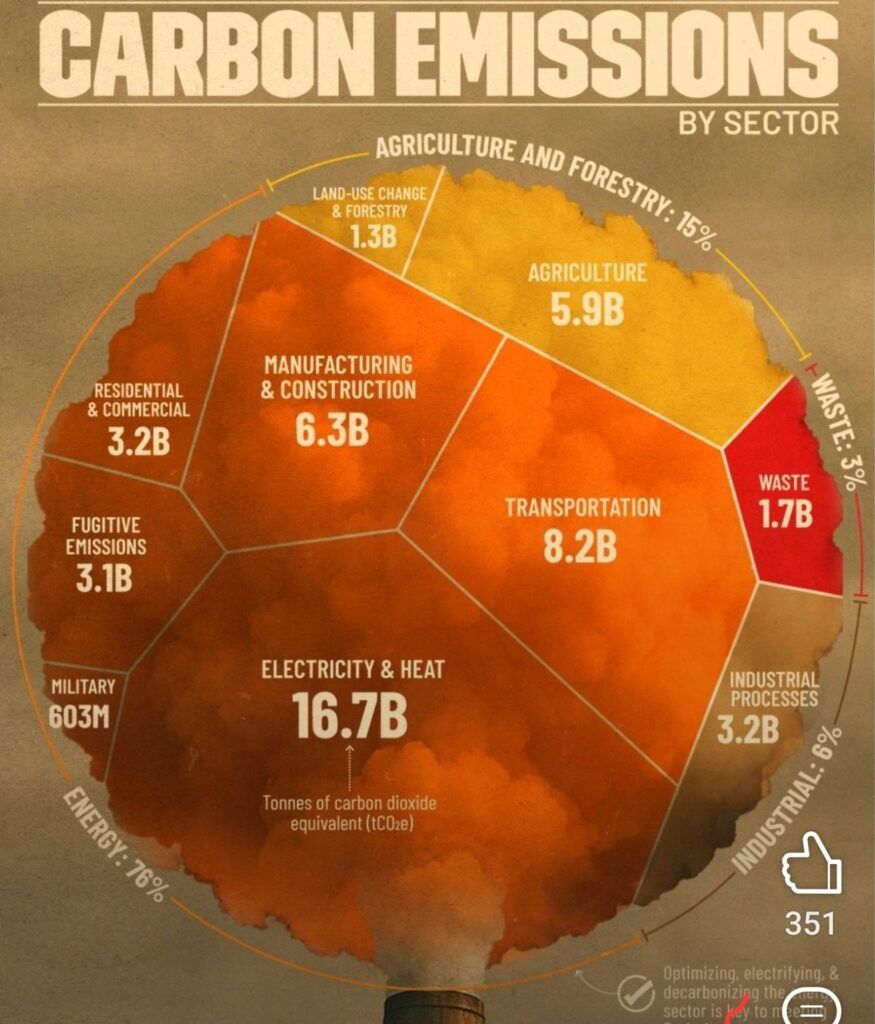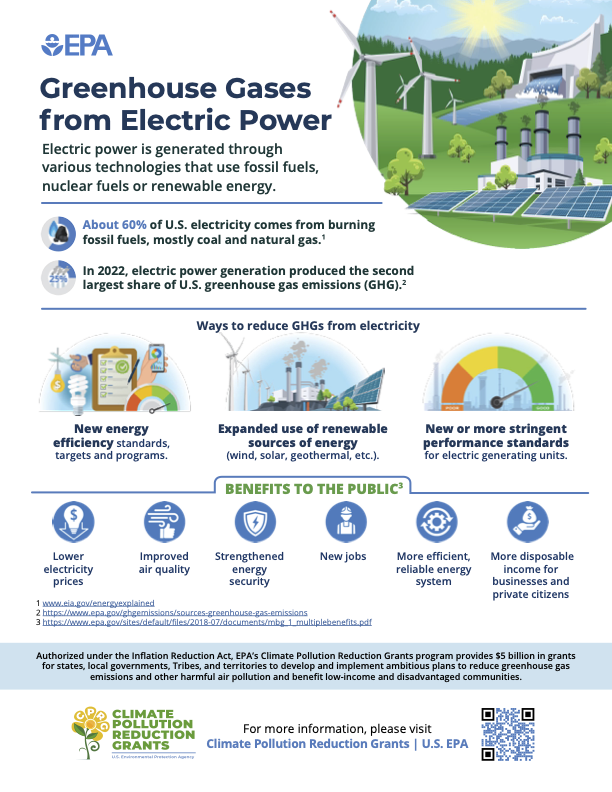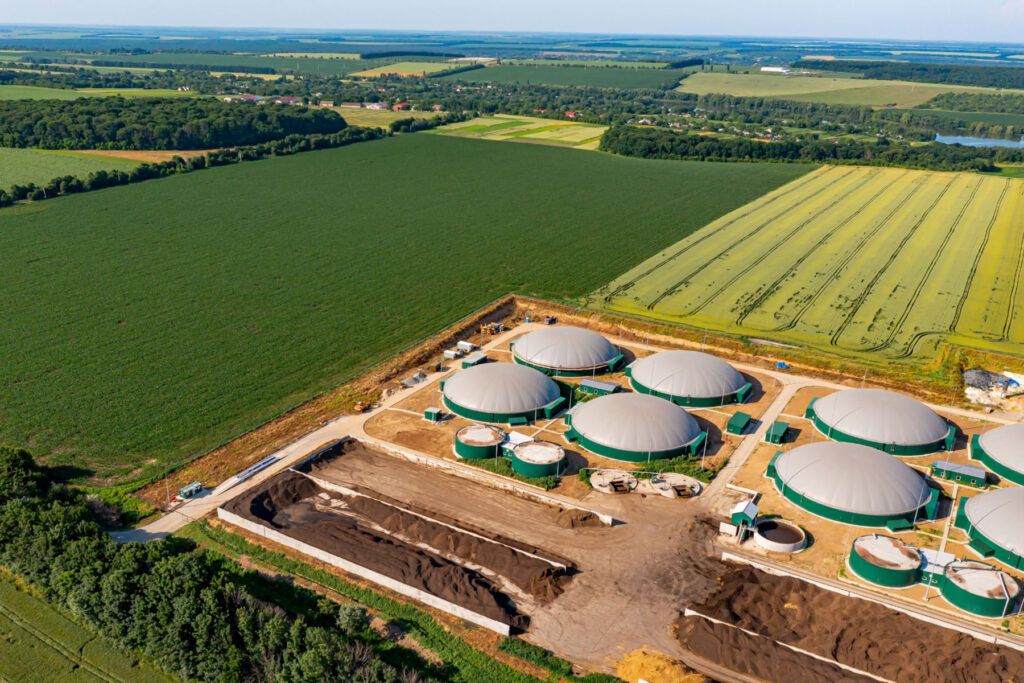Introduction
Energy powers the world: from the electricity that lights our homes to the fuel that drives industry and transport, we rely on various energy sources to sustain our way of life and economic and social development. However, behind this apparent convenience lies a worrying reality: energy production is one of the main causes of environmental pollution, causing serious consequences for human health.
Energy production using fossil fuels (coal, oil and natural gas) generates atmospheric pollutants, such as greenhouse gasesWhile the concentration of carbon dioxide (CO2) in the atmosphere has been steadily and rapidly increasing in recent decades, in May 2025, CO2 surpassed 43...
Read more (GHGs) that contribute to global warming, and toxic wastes which together impact both the environment and people. Emissions that severely damage air qualityAir quality refers to the state of the air we breathe and its composition in terms of pollutants present in the atmosphere. It is considered good when poll...
Read more and simultaneously contribute to climate change; as well as impacting the development of respiratory and cardiovascular diseases and even premature deaths.
Understanding the scale and scope of this environmental and health issue is the first step toward building a cleaner and healthier energy future. In this article, we invite you to explore how energy production impacts atmospheric pollution, its environmental consequences, effects on public health, and the alternatives science and technology offer to mitigate these impacts.

Emissions from the energy production industry
How energy production contributes to air pollution
Energy production from fossil fuels is one of the major sources of atmospheric pollution worldwide. When these fuels are burned to generate electricity, heat, or motion, they release a variety of harmful pollutants that threaten both health and our environment.
Fossil fuels and air quality
Fossil fuels mainly consist of carbon and hydrogen, but also contain impurities such as sulphur (coal and oil), nitrogen (from air during combustion), heavy metals such as mercury from coal, and complex organic compounds such as aromatic hydrocarbons (arenes) like benzene.
Air Quality Innovation in Just 1 Click
Stay informed about the air you breathe!
Subscribe to our newsletter to receive the latest updates on environmental monitoring technology, air quality studies, and more.
Burning these fuels causes a chemical reaction with oxygen in the air, which releases energy as heat and by-products. Since combustion is not a perfect reaction, it also produces harmful by-products that react with other gases and suspended particles in the atmosphere, resulting in notable environmental issues like smogSmog, beyond that dense fog
Smog is a mixture of air pollutantsAir pollution caused by atmospheric contaminants is one of the most critical and complex environmental problems we face today, both because of its global r...
Read more that accumulate in the atmosphere, especially in urban areas. This phenomenon is character...
Read more and acid rain.
Emissions from the energy industry
Key pollutants released to the atmosphere during fossil fuel use for energy production include:
- Carbon dioxide (CO2): produced by carbon combustion. It is the main greenhouse gas responsible for global warming.
- Carbon monoxide (CO)The carbon monoxide (CO) is an invisible gas (colorless and odorless) that, at the same time, is a silent killer because in just a few minutes it exhibits ...
Read more: produced by incomplete combustion when oxygen is insufficient. This toxic gas prevents oxygen transport in the blood. - Sulphur oxides (SOx): formed when sulphur in fuels like coal and oil oxidises during combustion. Sulphur oxides cause acid rain, respiratory irritation and worsen lung diseases.
- Nitrogen oxides (NOx): high combustion temperatures cause nitrogen in air to become reactive, producing smog and acid rain that damage soils, forests and water bodies. These gases also cause lung irritation.
- Particulate matter (PM2.5 and PM10): come from ash, soot and unburned fuel sprays. They cause serious health problems affecting lungs, heart and brain.
- Heavy metals: most (mercury, cadmium and lead) are impurities in coal and oil. They are highly toxic whether they remain in the environment or reach the nervous system.
- Hydrocarbons: volatile organic compounds (VOCs) released during incomplete combustion reactions. Once airborne, they react easily forming smog. Some VOCs, such as benzene, are carcinogenic.
In summary, burning fossil fuels produces useful energy but also pollutants inherent to their chemical composition that are released into the air due to combustion conditions.

Nuclear power plant producing energy in the vicinity of a population area
Sources of pollution in energy production
Energy generation, essential for human development, inevitably involves environmental impacts associated with each technology used. From the well-known effects of fossil fuels to the less obvious impacts of renewable energies.
Each source has a distinct pollution profile that should be assessed through a life cycle approach:
- Fossil fuels (coal, oil, natural gas): generate emissions (CO2, CO, SOx, NOx, PM, VOCs and heavy metals) due to their chemical composition and the oxidation reactions at high temperatures.
- Nuclear energy: nuclear fission generates energy without direct CO2 emissions, but produces radioactive waste (short-lived: low and medium activity, and long-lived: high activity lasting thousands of years).
- Renewable energies: although they operate cleanly, this is not always the case during their full life cycle.
- Photovoltaic: heavy metals and fluorinated gases are generated during solar panel manufacturing, alongside high energy consumption. Their waste after an approximate 25-year lifespan is difficult to recycle.
- Wind: cause social landscape conflicts and impact bird and bat populations due to wind turbines.
- Hydroelectric: emits methane (CH4), a potent GHG, from anaerobic decomposition of organic matter accumulated in reservoirs; also fragments river ecosystems disrupting ecological corridors for biodiversity.
- Biomass and biofuels: energy production is CO2-neutral because the carbon released was previously absorbed by plants. However, incomplete combustion due to oxygen deficiency generates CO, PM2.5 and black carbon emissions. High temperatures cause NOx emissions. Indirect impacts occur due to deforestation promoted by energy crops, releasing CO2 stored in soil and biomass, also due to fertiliser use to boost biomass for energy purposes.
In conclusion, each energy source presents specific environmental challenges, with fossil fuels being the most polluting, while renewables and nuclear energy require careful management due to significant life cycle impacts.

Carbon emissions by sector – Optimising energy production
Environmental impact of energy production
Energy production and consumption are among the main factors linked to the climate crisis, accounting for around 40% of CO2 emissions.
Climate change and energy production
The energy sector is the largest contributor to global warming due to its emissions of greenhouse gases (GHGs) that trap heat in the atmosphere, accelerating climate change. Additionally, it is an industrial activity that worsens air quality through its emissions; atmospheric pollution that causes changes in aquatic and terrestrial ecosystems, leading to biodiversity loss and habitat degradation. It is also directly linked to the occurrence of extreme weather events.
The feedback loop between energy production and climate has left a profound social, economic and environmental impact during: the recent heatwaves experienced in Europe, the US and Canada causing uncontrollable wildfires; hurricanes intensified by rising ocean temperatures; flooding that devastated Central Europe in 2021; and droughts that affected China with one of its worst in decades in 2022.
Of the emissions in 2023, those from fuel production (oil and gas infrastructure, coal mines), as well as road transport and energy-related industrial emissions, grew the fastest.

Degradation of ecosystems
Energy generation, especially from non-renewable sources such as fossil fuels, involves a range of environmental impacts that degrade air quality and damage terrestrial and aquatic ecosystems.
Some of the most harmful effects include:
- Air pollution: Burning fossil fuels in power plants and industrial facilities releases large amounts of pollutants causing smog, acid rain, ozone layer depletion, and contributing to global warming.
- Acid rain: Forms when sulphur oxides (SO₂) and nitrogen oxides (NOx), emitted from coal and oil combustion in power plants, react with water vapour in the atmosphere to form sulphuric acid (H₂SO₄) and nitric acid (HNO₃). This acidifies soils, reducing essential nutrients such as calcium and magnesium, weakening vegetation. In freshwater bodies it alters pH, affecting fish and amphibian species. Overall, it disrupts food chains and destroys biodiversity globally.
- Water and soil contamination: Industrial waste like coal ash contains heavy metals that leach into soil and aquifers. Oil spills during transport cause extensive damage to oceans and soil. Hot water discharged from nuclear power plants and other thermal power plants (coal, gas, etc.) used for cooling reactors raises the temperature of receiving water bodies, causing thermal pollution which reduces dissolved oxygen levels.
- Intensive resource exploitation: Energy production activities such as mining lead to deforestation and habitat destruction. Some mining techniques generate acids that contaminate surrounding water bodies and often require intensive water use.

Consumption of medicines for health conditions caused by pollution from energy production
Health effects of energy pollution
Worldwide, excess deaths from fine particulate matter (PM2.5) and ozone air pollution are estimated at 8.34 million per year. Most (52%) of this mortality burden is linked to cardiometabolic diseases, alongside strokes, chronic obstructive pulmonary disease (COPD) and cancer, as well as direct impacts on foetal development and child health.
“It is estimated that 5.13 million excess deaths annually worldwide are attributable to ambient air pollution caused by fossil fuel use and could therefore be prevented through phased elimination of fossil fuels.” Lelieved, J. et al. (2023) Air pollution deaths attributable to fossil fuels: Observational and modelling study.
Respiratory and cardiovascular diseases
Air pollution is a key determinant in the development and exacerbation of respiratory and cardiovascular diseases, due to its ability to trigger pathophysiological processes such as oxidative stress, systemic inflammation and endothelial dysfunction. Exposure to key pollutants such as fine particulate matter PM2.5, nitrogen dioxide (NO2), ozone (O3) and carbon monoxide (CO) is associated with a higher risk of hypertension, atherosclerosis, arrhythmias and thrombotic events. It also worsens chronic lung diseases such as asthma and COPD and exacerbates acute respiratory symptoms.
In the cardiovascular system, these pollutants increase the risk of acute myocardial infarction (1-3% per 10 μg/m³ PM2.5), as well as higher rates of stroke, heart failure and sudden death.
According to the Global Burden of Disease (GBD) Study, air pollution caused 4.2 million premature deaths in 2019 (7.6% of global mortality). Current data confirm that even brief exposures to PM2.5 increase cardiovascular mortality, while chronic pollution reduces life expectancy by 1-2 years in highly polluted areas.
In summary, atmospheric pollution, strongly influenced by energy production, is a critical but modifiable environmental risk factor that can be reduced through environmental and health policies to decrease its considerable impact on global mortality and morbidity.
According to the World Health Organization (WHO): Approximately 90% of the world’s population breathe air polluted beyond safe limits, posing a serious public health risk globally.
Long-term exposure and public health
Long-term exposure to atmospheric pollution is a major public health concern, increasing the general population’s risk of developing chronic diseases and premature mortality from chronic exposure to pollutants such as fine particulate matter (PM2.5 and PM10), sulphur dioxide (SO2), and nitrogen dioxide (NO2).
An increase of 10 µg/m³ in PM2.5 concentration can raise mortality and lung cancer cases by 15% to 27%. Air Plan 2017-2019. Impact of air quality on health in Spain. Ministry of Health of the Spanish Government.
Negative effects do not affect everyone equally; there are especially vulnerable groups: children, particularly sensitive due to immature respiratory and immune systems, may develop reduced lung function growth and increased asthma and respiratory infections. Similarly, elderly people and those with pre-existing respiratory and heart conditions are at increased risk of severe complications and mortality associated with chronic exposure to air pollutants. Just as air pollution can worsen existing diseases, it has been linked to the development of new conditions and neurological disorders such as Alzheimer’s and Parkinson’s in older adults.
Ultimately, scientific evidence shows that there is no safe threshold for exposure to air pollutants. Even low concentrations can increase mortality and serious disease incidence, disproportionately affecting the most vulnerable groups.

Gases de efecto invernadero de la energía eléctrica – EPA de EE. UU.
Solutions to reduce pollution in the energy sector
The transition to clean and renewable energy is not only essential to mitigate climate change but also to prevent millions of premature deaths associated with air pollution from energy production. According to the World Health Organization (WHO), more than 90% of the global population breathes air with dangerous levels of fine particulate matter (PM₂.₅), largely originating from the burning of coal, oil and gas.
If these fuels were replaced by renewable energies accessible to all, atmospheric pollution would cease to be one of the main environmental threats to human well-being. Studies from the IPCC and the International Energy Agency confirm that replacing coal, oil and gas with renewables (wind, solar, hydroelectric) would reduce CO₂ and atmospheric pollutant emissions by up to 80% by 2050.
Replacing fossil fuels would avoid 5.1 million annual deaths from PM₂.₅ exposure (Dinh, N.T.T., 2024) and 1.8 million (12%) new cases of childhood asthma linked to NO2. (Harvard and George Washington Universities, 2022).
Transition to renewable energies
Decarbonising the energy sector can be achieved through the most effective renewable technologies for reducing pollution: those that generate electricity without emitting atmospheric pollutants or GHGs.
Among these are: the use of solar and wind energy, renewable sources that in 80% of countries are already cheaper than coal (2024). Hydroelectric power generates electricity from moving water. While dam construction impacts river ecosystems, once operational, energy generation is clean and renewable. Biomass energy uses organic waste to produce energy; when managed sustainably it can be a sustainable and renewable alternative. Geothermal and marine energy harness heat from underground and the movement of tides and waves; still in development in many places, but with great potential to complement the clean energy mix.
[The Global Electricity Review 2024 report (ES and EN) contains interesting charts: https://ember-energy.org/latest-insights/global-electricity-review-2024/]
An energy transformation based on renewables can be supported by battery storage and energy distribution via smart grids to ensure stable supply. Added to this is green hydrogen, notable for its use in heavy industry and transport sectors, as well as overcoming the intermittency issues renewables face.
Together, adopting these clean technologies for energy production allows dramatic reductions in air pollution, improvements in public health and progress towards a sustainable and environmentally friendly energy model.

EU energy mix by the European Environment Agency
Policies and regulations for cleaner energy
The energy transition to cleaner production sources is advancing in most countries, with greater incorporation of renewables into their energy mix. International and national regulations, together with innovation incentives and investment in clean technologies, are key to controlling pollution caused by the energy sector and promoting a transition to more sustainable sources.
The growth of renewables is robust but the energy industry alone is insufficient to meet global climate targets. Decisive and sustained political action, especially in hard-to-decarbonise sectors, is essential. This will enable the maintenance and advancement of new technologies and the modernisation of existing energy infrastructure. Coupled with increasingly strict emissions regulations within international commitments, this is accelerating the transition to cleaner, more sustainable energy production.
Main regulations include:
- United States: the Clean Air Act is enforced by the Environmental Protection Agency (EPA) to regulate GHG and pollutant emissions from power plants. Besides setting limits and reduction requirements, it promotes mitigation technologies like carbon capture and storage.
- European Union: the European Green Deal aims to achieve climate neutrality for Europe by 2050. Intermediate goals include reducing emissions by at least 55% by 2030 (compared to 1990) and constant legislation updates prioritising energy efficiency and renewable energy development.
- Global: the Paris Agreement commits nearly 200 countries to limit global temperature increase to below 2°C by setting national emission reduction targets. The Agreement also promotes international cooperation for decarbonising the energy sector.
Frequently asked questions about air pollution from energy production
How does energy production pollute the air?
Energy production, especially from fossil fuels like coal, oil and natural gas, is one of the main sources of atmospheric pollution globally. The combustion of these materials releases a variety of pollutants into the air that affect both the environment and human health.
The main pollutant gases emitted are:
- Nitrogen oxides (NOx): produced in processes that use fuels at high temperatures, such as car engines and thermal power plants. They cause photochemical smog and acid rain.
- Sulphur dioxide (SO2): originates from burning coal and oil, a chemical process that releases sulphur impurities into the air. It causes acid rain that damages vegetation and buildings. It also causes respiratory damage and worsens existing lung problems such as asthma and bronchitis.
- Particulate matter (PM2.5 and PM10): comes from ashes, soot and secondary aerosols. It causes serious respiratory problems, especially the finer particles (PM2.5), which can penetrate the bloodstream from the lungs.
- Greenhouse gases (CO₂, CH₄): Carbon dioxide (CO₂) is the main gas responsible for climate change, while methane (CH₄), although emitted in smaller quantities, has a much greater global warming potential.
What are the main pollutants emitted by power plants?
Power plants, especially those using coal and other fossil fuels, are responsible for the emission of various atmospheric pollutants such as carbon dioxide (CO₂), methane (CH₄), sulphur dioxide (SO₂), nitrogen oxides (NOx) and particulate matter (PM)Atmospheric particulate matter are microscopic elements suspended in the air, consisting of solid and liquid substances. They have a wide range of sizes an...
Read more. These gases and particles contribute to global warming, the formation of acid rain and the degradation of air quality, which increases the risk of developing respiratory and cardiovascular diseases in populations living near power plants.
How does pollution from energy production affect health?
Air pollution generated by energy production, especially from fossil fuels such as coal, oil and gas, has serious effects on human health. Energy production releases harmful substances such as fine particulate matter (PM2.5), sulphur dioxide (SO₂), nitrogen oxides (NOx) and heavy metals. Prolonged or acute exposure to these substances is associated with the development of respiratory diseases (asthma, chronic bronchitis, respiratory crises) and cardiovascular diseases (heart attacks, strokes), as well as increasing the risk of premature death.
How do renewable energies help reduce pollution?
The most effective renewable technologies to reduce pollution are those that generate electricity without emitting greenhouse gases or atmospheric pollutants. These include:
- Wind energy: the most efficient for reducing pollution, as it converts wind into electricity without producing polluting emissions. It can also replace the use of large volumes of fossil fuels.
- Solar energy: one of the most accessible and widespread sources, producing no emissions during operation and significantly contributing to carbon footprintIn a world increasingly affected by climate change, understanding how our everyday actions contribute to its worsening has become essential. The carbon foo...
Read more reduction. - Hydroelectric energy: harnesses the energy of moving water to generate electricity.
- Biomass energy: uses organic waste to produce energy. It can be a clean and renewable alternative if managed sustainably.
- Geothermal and marine energy: utilise heat from underground and the movement of tides and waves.
- Green hydrogen: produced via electrolysis with renewable energy. A promising solution to decarbonise sectors difficult to electrify directly.
What regulations exist to control pollution in the energy sector?
International and national regulations, along with incentives for innovation and investment in clean technologies, are the key to controlling pollution caused by the energy sector and promoting a transition to more sustainable sources.
- United States: The Clean Air Act is enforced by the Environmental Protection Agency (EPA) to regulate greenhouse gas and pollutant emissions from power plants. Besides setting limits and reduction requirements, it promotes mitigation technologies such as carbon capture and storage.
- European Union: The European Green Deal aims to achieve climate neutrality in Europe by 2050. Intermediate targets include reducing emissions by at least 55% by 2030 (compared to 1990) and ongoing legislative reviews to prioritise energy efficiency and renewable energy development.
- Global: The Paris Agreement commits nearly 200 countries to limit the global temperature rise to below 2°C by setting national emission reduction goals. The Agreement also fosters international cooperation to decarbonise the energy sector.

Wind energy as a source of renewable energy production
Conclusion
Science doesn’t lie: energy production based on fossil fuels has a deep and negative impact on both public health and the environment. Its use leads to more respiratory and cardiovascular diseases and exposes the most vulnerable among us — children, the elderly and those with pre-existing conditions — to premature death. Yet, it is also true that we have never before had so many tools, knowledge and opportunities to reverse this situation.
The transition to cleaner, more sustainable energy sources is already underway worldwide. Through decisive and ambitious policies, technological advances and growing social awareness, the development of renewable energies, modernisation of electrical grids and reduction of air emissions are being driven forward. Every action counts: from designing public policies and investing in clean infrastructure, to the everyday choices of industries and citizens. The challenge is great, but the potential for change is even greater. Acting now will allow us to enjoy cleaner air, healthier societies and a more sustainable planet for all.
References
- Perera, F. (2023). The impact of fossil fuel combustion on children’s health and the environment: The need for a new paradigm. The Lancet Planetary Health, 7(3), e210-e216. https://www.researchgate.net/publication/365777296_A_Myriad_of_Health_Impacts_from_Fossil_Fuel
- Lelieveld, J., Haines, A., Burnett, R., Tonne, C., Klingmüller, K., Münzel, T., & Pozzer, A. (2023). Air pollution deaths attributable to fossil fuels: Observational and modelling study. BMJ, 383, e077784. https://www.bmj.com/content/383/bmj-2023-077784
- Ubilla, C. & Yohannessen K. (2017). Contaminacion atmosférica, efectos en la salud respiratoria del niño. Revista médica clínica Las Condes. Vol. 28. Núm. 1. págs 111-118 https://www.elsevier.es/es-revista-revista-medica-clinica-las-condes-202-articulo-contaminacion-atmosferica-efectos-en-la-S0716864017300214
- Southerland, C. et al. (2022). Global urban temporal trends in fine particulate matter (PM2·5) and attributable health burdens: estimates from global datasets. The Lancet Planetary Health, Volume 6, Issue 2, e139 – e146. https://www.thelancet.com/journals/lanplh/article/PIIS2542-5196(21)00350-8/fulltext
- Dinh, N. T. T. et al. (2024). Measuring and valuing the health co-benefits of climate change mitigation: a scoping review. The Lancet Planetary Health, Volume 8, Issue 6, e402 – e409. https://www.thelancet.com/journals/lanplh/article/PIIS2542-5196%2824%2900095-0/fulltext
- Zhao, X., Zhang, X., & Li, N. (2023). Assessing the environmental impacts of renewable energy sources: A case study of wind and solar energy in China. Journal of Environmental Management, 330, 117013. https://www.sciencedirect.com/science/article/pii/S0301479723013130
- European Environmental Agency. (2020). Development of Renewable Energy and its Impact on Air Quality: Co-benefits and Trade-offs. ETC/ATNI Report 6/2020. https://www.eionet.europa.eu/etcs/etc-atni/products/etc-atni-reports/etc-atni-report-6-2020-development-of-renewable-energy-and-its-impact-on-air-quality-co-benefits-and-trade-offsEionet Portal
- U.S. Environmental Protection Agency. (2025). Human Health & Environmental Impacts of the Electric Power Sector. https://www.epa.gov/power-sector/human-health-environmental-impacts-electric-power-sectorUS EPA









